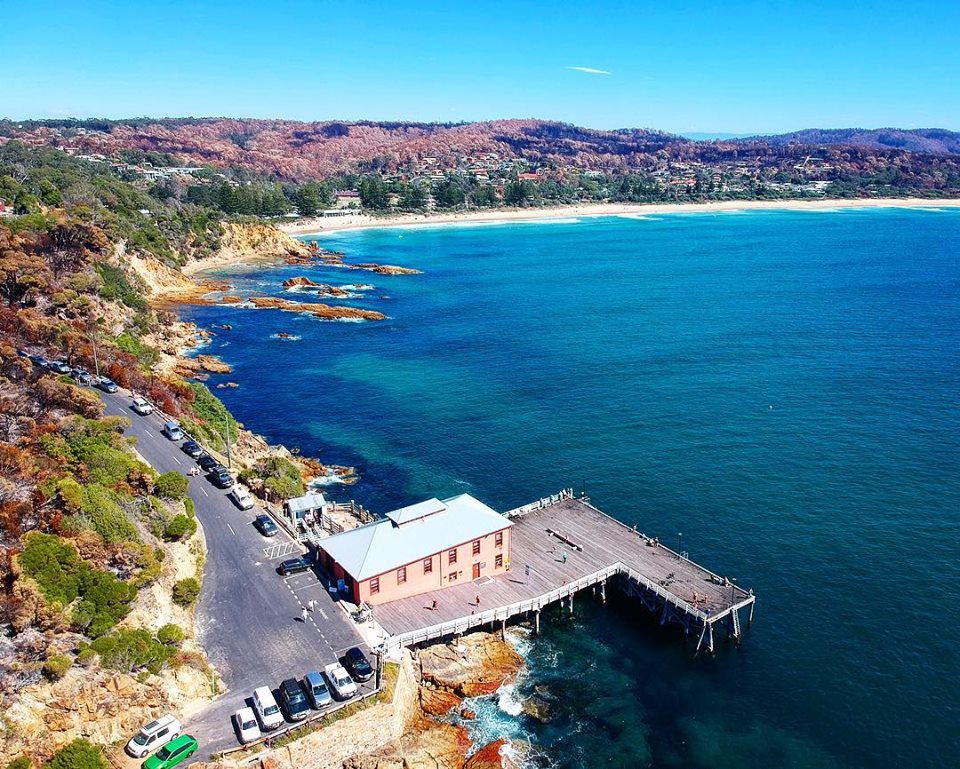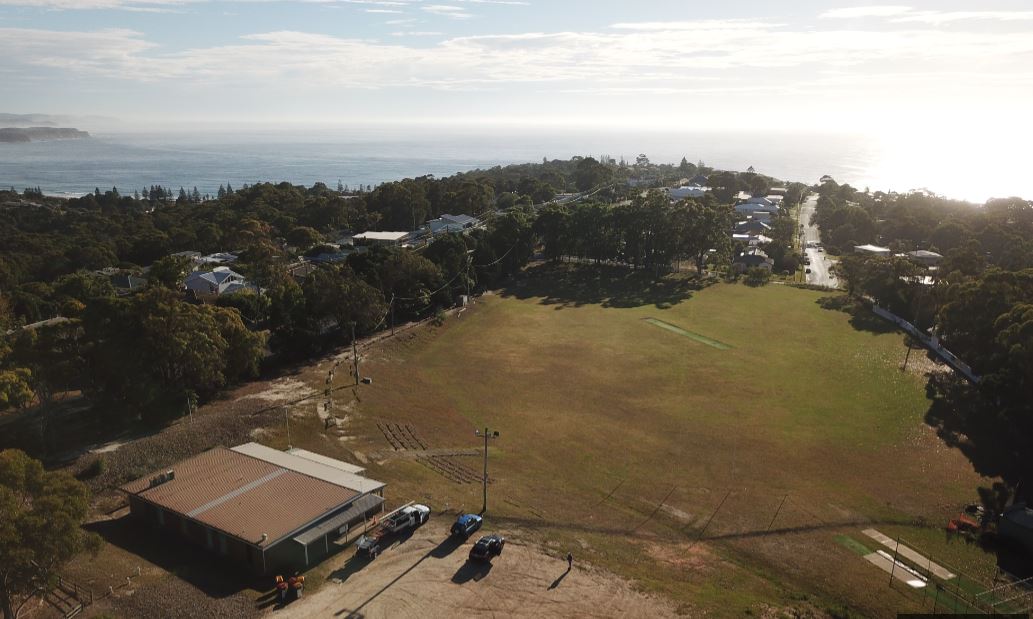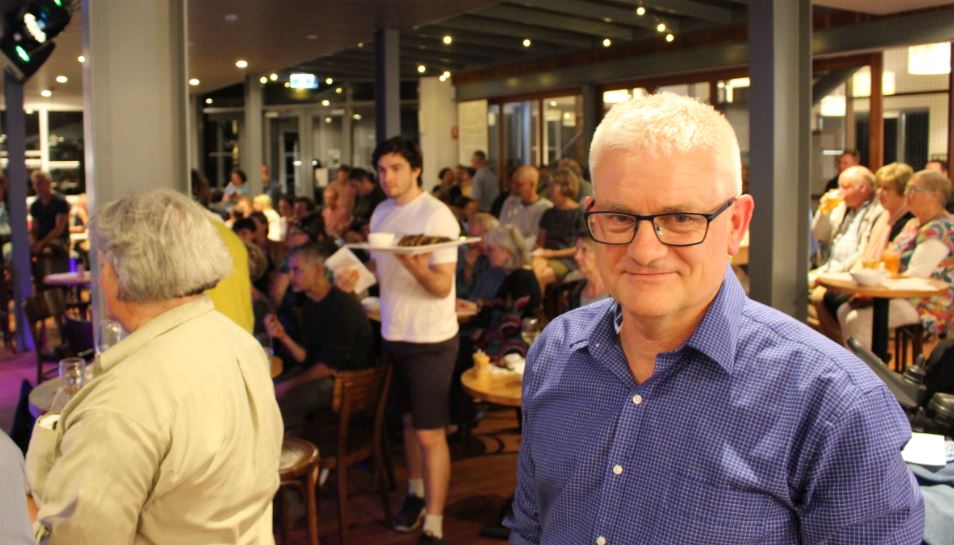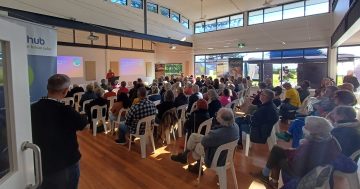A town that has championed grassroots action against climate change has perhaps fallen victim to it, according to a longtime greenhouse gas campaigner.
Tathra resident and local orthopaedic surgeon, Dr Matthew Nott believes the bushfire that scorched his town on March 18 was supercharged by climate change.
As the founder of Clean Energy for Eternity, Dr Nott and his group have been successful in raising funds over the last 12 years to install solar panels on all but one of Tathra’s community buildings – the one left is the Aussie Rules clubhouse at Lawernce Park, fundraising is underway now.
Speaking at Tuesday nights meeting of the Sapphire Coast Regional Science Hub at Tathra Pub, Dr Nott explained it was time to draw a link between the loss of 65 homes three weeks ago and the impacts of increasing carbon dioxide levels in the atmosphere.
“I really understand the sensitivity of talking about climate change when friends of mine have lost everything except the shirt on their backs,” he says.
“So, is this climate change? That’s a really difficult question to ask and its a really difficult question to answer right now.”
A crowd of around 150 people, some of whom had lost their homes, listened on.
“My answer to that is – we know the planet is warming, we know that south-east New South Walse is warming, we know that extream heat days are becoming more frequent, and we know that the bushfire season is longer.
“March was the seventh hottest month ever recorded in NSW, but the eighteenth (18th) of March was an extraordinary day,” Dr Nott explains.
“It (March 18) saw the hottest March temperatures every recorded between Sydney and Eden, Sydney was over 40 degrees on that day.
“You can’t say that this bushfire was caused by climate change but you can say that this kind of bushfire is going to occur more frequently as we get hotter,” he says.

Tathra is in recovery mode following the March 18 bushfires. Photo: Andrew Buesnel Instagram.
Tuesday nights pub talk was a clarion call for bush coastal communities dotted along the Far South Coast, towns like Tathra surrounded by bush with limited access in and out.
“We’ve only just started to see climate change, it’s about to get a lot worse,” Matthew Nott says.
“We need to start preparing for this type of catastrophe and we need to start warning other communities.”
The Bega Valley has heard Dr Nott speak many times, but this is perhaps the most strident they have seen him, and as he tends to do, the respected surgeon pointed to the solutions and opportunities.
“How much more fossil fuel can we burn?” he asks.
Pointing to data from NASA, Dr Nott suggested if fossil fuels continued to be burnt at their current rate (13 billion tonnes per year) the world would need to stop burning coal and oil altogether in 15 years time to stay under the 2-degree warming target set by the Paris Climate Agreement in 2015.
“We have already warmed by 1.1 degrees,” he says
“The longer we take to start reducing our emissions the more drastic our actions are going to have to be.”

Fundraising is underway to install solar panels on the Aussie Rules clubhouse at Lawrence Park Tathra. Photo: Matthew Nott.
Dr Nott then detailed the amount of coal left in the ground, “About 15 times more than is required to warm our plant by 2 degrees, we have to leave fossil fuels in the ground.”
Closing the Liddell Power Plant in the Hunter Valley by 2022 is key according to Dr Nott as is shutting down the development of Queensland’s Adani Coal Mine.
“The Chairmen of AGL (owners of the Liddell Power Plant) says they are going to replace it with renewable energy, with gas, with battery storage, and that that is going to be cheaper than keeping this thing (Liddell) going.”
And when it comes to Adani, “About 3 billion tones are going to come out of this mine, this is not the time to be opening up the biggest coal mine that Australia has ever seen.”
“If this mine goes ahead it will wipe out any attempt that Australia makes to reduce our emissions many times over,” Dr Nott claims.
In closing, Dr Nott called on the community to continue to show leadership and action on climate change.
He pointed to the new solar installation on the roof of Tathra Beach Bowling Club Club, “This has nothing to do with Clean Energy for Eternity or community fundraising, this is a big installation about 40 kilowatts, that they put in themselves because that was the cheapest thing to do, solar energy is now cheaper than coal-fired electricity.”
Australia’s 305 surf clubs are the next aim for Clean Energy for Eternity (CEFE), solar panels powering lifesavers is the aim. CEFE has already assisted Far South Coast clubs to go solar except one, the newly renovated Batemans Bay Surf Club at Malua Bay – donations are now open to help make that happen.
“There is so much at stake, the way that this town has coped with the catastrophic bushfires is a testament to the strength of this community, we will rise above the fire and be stronger than ever, leadership on climate change is part of that,” Dr Nott says.
*This article first appeared on RiotACT











